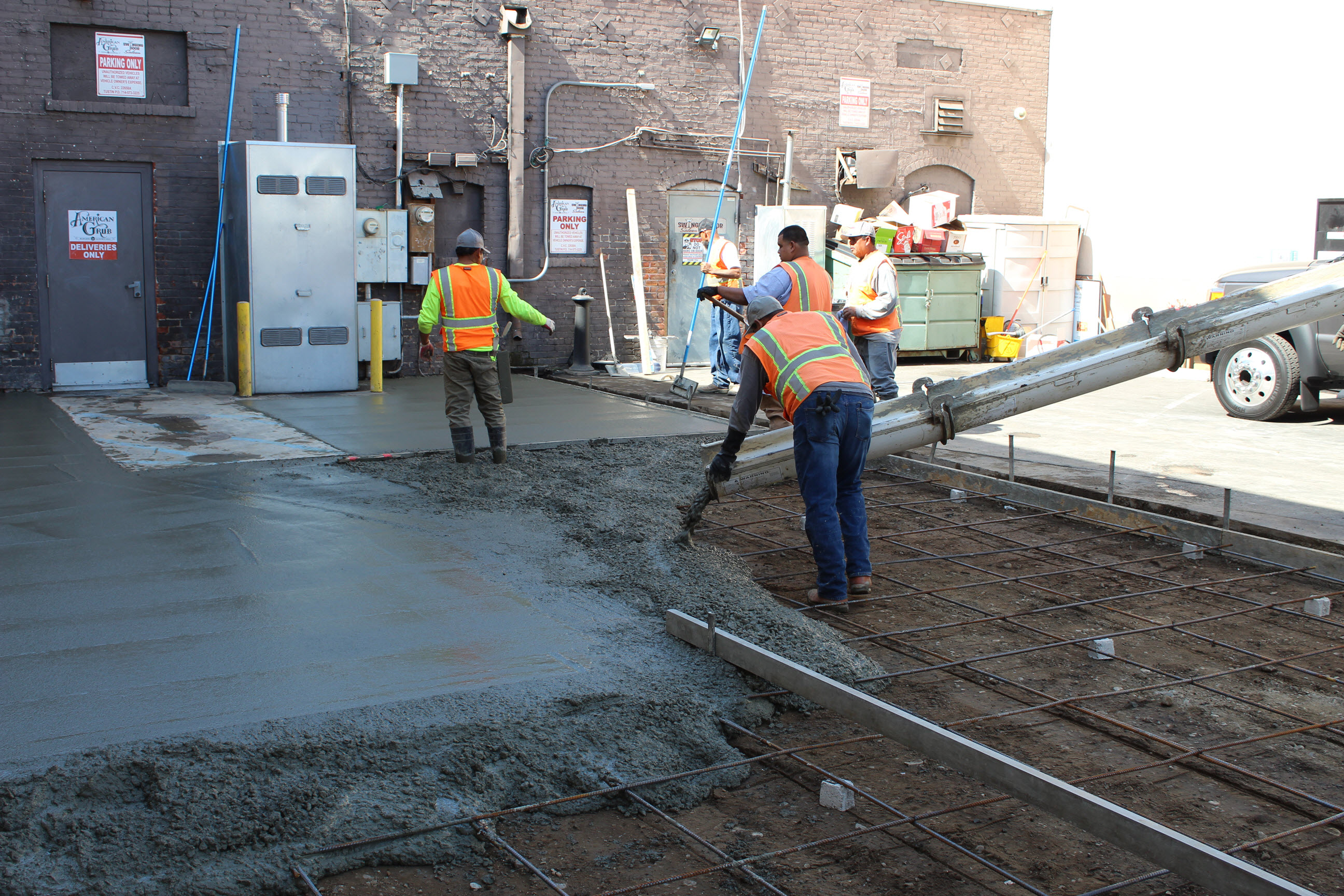The ideal temperature for pouring concrete is between 50 and 60 degrees Fahrenheit. This is because concrete gains its strength and durability through a process known as hydration, which can be affected by conditions of extreme heat or cold.

How Concrete Works
In order to understand why the right temperature is so important for pouring concrete, it's important to know the basics of how concrete works.
Concrete is like a recipe that has two key "ingredients:" aggregate and paste. The aggregate is a combination of sand and broken gravel mixed together in the proper amount. The paste is a mixture of water and cement (cement is a fine powder that contains several elements, such as finely ground stone, ash, and other minerals).
When the aggregate and paste are mixed together, they form a gooey substance that is easily poured and can be formed into a variety of shapes and molds. However, once this substance is left alone for a while, it begins to harden. Eventually, it solidifies to the point of being rock-like.
The Importance of Hydration
Even after concrete has set, it gains increased strength through the hydration process (aka "curing"). This involves the compounds in the cement mixture chemically reacting with the water molecules in the concrete. These chemical reactions result in cement particles joining together, creating a stronger, more cohesive substance.
While the concrete will harden within a relatively short time after the initial pour, the hydration process will continue for weeks, even months thereafter. That's why people in the know say that concrete grows stronger with time. However, if concrete is poured or cured in extreme temperatures, the hydration process may not work as it should.
Why it's Important to Maintain the Correct Temperature
The initial pour, and the first 72 hours after the pour, is the most critical time in the hydration process. The chemical reaction in which water molecules help to bind cement particles to one another is affected by heat - or the lack thereof. This means that pouring concrete during summer or winter months may come with additional challenges.
Risks of Pouring Concrete in Hot Weather
Temperatures that exceed 90 degrees Fahrenheit may alter the ratio of water, cement, and aggregate due to water evaporation. This may result in a weaker final product, as well as abnormalities in shape or form.
However, the risks associated with hot weather pale in comparison to the risks of pouring concrete in cold weather.
Risks of Pouring Concrete in Cold Weather
When pouring concrete in temperatures below 40 degrees Fahrenheit, the hydration process may take up to 24 hours longer. However, the most dangerous aspect of pouring concrete in a cold environment is when the water in the cement mixture freezes and expands. This expansion can result in the top layer of fresh concrete breaking off from the layers underneath. In the worst case scenario, it can eventually cause building foundations to crack under the weight of the superstructure, resulting in total collapse.
In addition, even if the cement mixture itself remains unaffected by the cold, if concrete is poured onto an extremely cold or frozen surface, then it may fail to harden correctly. Over time, the layers of concrete may shift, causing severe structural damage to any building on top.
Ways to Achieve the Best Temperature When Pouring and Curing
Even when pouring concrete in extreme temperatures, there are steps that professionals can take to achieve success. In hot weather, these steps may need to be taken:
- The workers will avoid pouring during the hottest parts of the day (noon and afternoon).
- They may use coarser (larger) aggregate particles in the concrete mix, which will minimize the risk of shrinkage from the heat.
- They may cool down the aggregate by periodically spraying water over the batch.
- They may use ice as part of the cement mixture, or liquid nitrogen to cool the batch.
There are also certain steps for cold weather pouring that may prove effective, such as:
- Using heaters or heated mats to thaw frozen ground
- Mixing in hot water with the cement
- Using extra cement to make the chemical reactions hotter, and speed up hydration
- Using additives designed to quicken the hardening process
- Using heated concrete mixes or special blends designed for use in cold weather
- Using chemical accelerators to speed up the curing process
- Keeping the concrete's molds or framework in place until the hardening process is completed (early removal will lead to the concrete's collapse)
Once the concrete has been set, it's important for it to remain at a temperature above 50 degrees Fahrenheit for at least the next two days in order to finalize the curing process. There are a few ways to keep the concrete within the proper temperature range, such as:
- Using a heated enclosure that is protected from wind, rain, and water. It is vital that such an enclosure has enough ventilation for the space heater inside, to avoid accidental carbonation of the concrete's surface.
- Covering the concrete with insulated blankets.
- Laying straw over the concrete's surface to serve as an insulating material.
Partnering with the Concrete Experts
Laying concrete in ideal weather conditions requires skill, knowledge, and experience. This is even more true when a concrete pour must be completed in temperatures of extreme heat or cold. One wrong move or incorrect calculation could result in a weaker final product, extra work in the short term, and potentially dangerous structural consequences in the long run.
At Empire Parking Lot Services, our concrete professionals have years of training and experience under their belts, and know how to successfully complete a concrete pour no matter how hot or cold it may be. Furthermore, our workers have the required skills to perform repairs on concrete parking lots, sidewalks, and other surfaces as needed.
If you want to embark on a concrete-related project in the upcoming weeks or months, then partner with the concrete experts at Empire Parking Lot Services. Contact us at 714-633-0300, or reach out to us through our website. We'd be happy to assist.
Other Concrete Related Blogs:
- Concrete vs Asphalt: Which Is Better and Why?
- How Thick Should a Concrete Sidewalk Be Poured?
- How Long Should I Wait Before Driving on New Concrete?
- What Causes Concrete Sidewalks to Crack, Sink, and Heave?




Comments